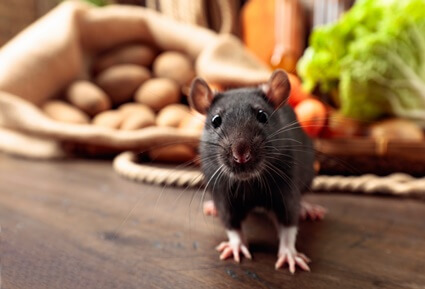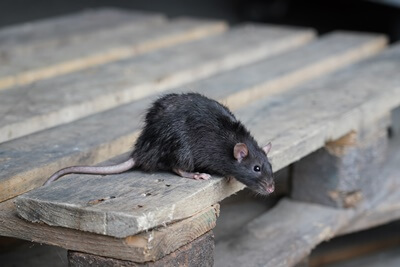Rats travel for food and water in the darkness of the night and scurry away when a light flickers on.
They choose different items based on color, track urine marks, and spot food from great distances. If you’ve ever tried to catch a rat, you know how quickly it can spot you and run away.
Rats have poor vision because they’ve evolved into seeing better during the twilight hours. They also lack depth perception and are not good at judging sizes and distances.
Rats can see with great clarity up to 3 feet away. With blurred vision, they can see an additional 43 feet.
Rats can only see blue and green clearly; new studies show that rats can also perceive red. They mostly rely on their ultraviolet and binocular vision to see food, locate escape routes, and avoid predators.
What Is a Rat’s Vision Like?
In terms of clarity and color perception, rats have poor vision. They can’t see objects more than a few feet away and can only discern 2 colors fully.
However, they have a much broader field of view than humans. Due to their binocular vision, they can simultaneously see 2 items on different sides of their bodies.
Overall, rat vision is rated 20/600, considerably lower than most mammals. Nonetheless, rats’ eyes have much in common with human eyes. They have similar aspects, including the:
- Cornea.
- Pupil.
- Lens.
- Retina.
These parts work almost identically in both species. That said, there are a few fundamental differences in how rat eyes work.
For example, light passes through a rat’s cornea and pupil, just like in humans.
However, rat lenses allow more light to pass through – almost all visible light and 50% of UVA light. This will enable rats to see ultraviolet light, which humans cannot perceive.
The exact function of this ultraviolet vision is not yet known. Nonetheless, preliminary studies show that the list of potential benefits includes:
Urine-Mark Visibility
Most humans can identify urine only if there’s a puddle and accompanying smell. However, it’s distinctly visible under ultraviolet light, even when dried and odorless. Thus, rats can visibly see urine markings.
This ability to detect urine traces enables rats to identify active and abandoned pathways, increasing their chances of successful foraging.
Twilight Foraging
Although functionally nocturnal, most rats are also active during twilight hours.
These times of day are neither dark nor bright, and ultraviolet light is still available. This helps rats identify food, routes, and potential hiding spots before proceeding to their foraging missions.
Reduced Visibility
Rats are not the only animals that can see ultraviolet light.
A rat’s underbelly is more reflective than its back. As such, rats may stand on their hind legs to expose themselves to other rats. They will then hunch their backs to make themselves less visible to predators.
Do Rats Have Bad Eyesight?
Rats don’t have good eyesight, especially compared to other mammals.
Their eyes are small in size, and their lenses are not flexible. The latter means they cannot withstand bright, direct light for extended periods nor change their focus when looking at things.
A rat’s visual acuity, which is the ability to see things clearly, is about 20 times worse than that of humans. The low acuity is often attributed to the coarse neural grains covering a rat’s retinas.
These make the eyes more sensitive to light and movement, albeit at the expense of acuity. In other words, their eyes work best at night when detail isn’t as necessary as spotting a moving predator.
Despite their poor eye structures, rats do have a great depth of focus. This is the distance (behind the retina) over which the eye can focus on an object without a considerable loss of sharpness.
The depth of focus in rats ranges from 7 cm to infinity.
In comparison, that of humans ranges from 2.3 meters to infinity. If you account for the size difference between the two mammals, the depths are more or less the same.
The depth of focus also affects how rats perceive blurriness and, consequently, how far they can see.
On average, rats start seeing blurs after a 14-diopter (0.07 m) change in focus. In humans, blurriness is apparent after a 1/3 diopter (about 0.33 m) change.

How Far Can Rats See?
Rats can only focus clearly on objects a maximum of 2 feet away.
This seems shortsighted from a human perspective but is quite far from a rat’s point of view. Once blurriness is accounted for, rats can see objects (albeit in large, obscure shapes) from as far as 45 feet.
To compensate for this poor vision, rats develop other senses to spot movements and environmental changes. This gives them insight into their surroundings, even if they can’t distinctly view them.
In particular, a rat’s whiskers are sensitive and play a significant role in movement coordination.
According to the University of Sheffield, rats depend more on their whiskers than their eyes to move around in the dark. This is similar to how humans use hands and fingers.
Albino rats, about 2% of the global rat population, lack pigmented irises.
Hence, they have much worse eyesight. The unpigmented irises allow light to pass through to the retina unencumbered, causing retinal degeneration and a considerable decrease in acuity.
It’s estimated that albino rats only have sharp vision less than one foot away. Otherwise, they only see shifting and undefined shadows.
Can Rats See Infrared Light?
Rats and mice, like most animals, cannot see infrared light.
Their eyes can only perceive light and photons with wavelengths between 400 and 700 nanometers, which are called visible light. Most animals can see visible light under normal circumstances.
Infrared light, which usually has a wavelength of 780 nanometers, falls above the limits of visible light. Thus, it’s filtered out by the lens and cornea before it reaches the visual cortex.
Since rats have an eye structure similar to humans, scientists have attempted to make rats see, or at least “feel,” infrared light. These tests are designed to, one day, help humans do the same.
According to Nature Communications, researchers fitted test rats with infrared detectors connected to microelectrodes implanted in their visual cortex.
The rodents responded positively. All specimens could track and identify the position of the infrared light device used in the study, even in the dark.
According to the Journal of Neuroscience, researchers managed to elicit a visual response and a change in behavior from the rodents under study.
Both studies indicate that rats could be outfitted with better vision in the future.
This could ensure that blind rats have their sight restored using panoramic infrared sensory prosthetic systems. The goal is to accomplish this without interfering with other visual and sensory cortex functions.
How Many Colors Can Rats See?
Rats have dichromatic vision, which means they have 2 color-sensitive cones in their eyes.
One of the two cones contains UV-sensitive cells and primarily detects bluish colors. The other has cells sensitive to M lights (lights in the middle of the visible spectrum). They mainly detect shades of green.
Humans also have the same types of cones and color vision.
However, we have an additional cone that can see reds. For rats, most shades of red appear as undefined dark shades. Just note that this was determined by older research.
According to Animals, the long-held position that rats are red-light blind may be disproved. Researchers primarily looked at the sensitivity of rat retinas to red lights in both dark and light conditions.
Surprisingly, the results revealed that rat retinas respond to red light in both circumstances, and they do it with great sensitivity.
Of course, this doesn’t imply that rats are trichromatic like humans. Research is still being conducted on how rats perceive red beyond our understanding of their retinas.
Instead, it proves that rats can be disoriented by flashing red lights and bright headlamps. This may one day develop into a pest control method.
Can Rats See In Different Directions?
Rat eyes are not structurally synchronized like ours and can move in different positions. As such, rats can see objects and their environment in each direction.
This gives them a wide visual field, which helps them identify predators and potential escape routes simultaneously. Of course, what a rat sees depends on how its head is positioned.
- If the rat looks down, the eyes will roll backward, giving a much larger view of what’s happening on the sides.
- The eyes look forward when looking up, providing a cross-eyed appearance and a larger point of view of the objects in front.
- If the head bends to one side, the eye on the lower side moves up, while the upper eye moves down.
The last position gives the rat a view of things above it, such as a bird flying close. These uncoordinated eye movements let rats keep a permanently crisp view of the areas above their heads on both eyes.
Many scientists believe this to be an evolutionary adaptation. Most predators of rats in the wild happen to be birds. The downside is that the two visual fields do not merge in rats like humans.
Do Rats See Better in The Dark or Light?
Although rats are nocturnal animals, they don’t have perfect vision in the darkness.
Sensitivity to bright light means a rat’s eyes grow watery and blurry during the day. In simple terms, rats have poor vision and can’t see clearly in dark or light environments.
Rats can, however, see better in the twilight hours when the conditions are more balanced. This explains why they are more likely to leave their nests at these times.







